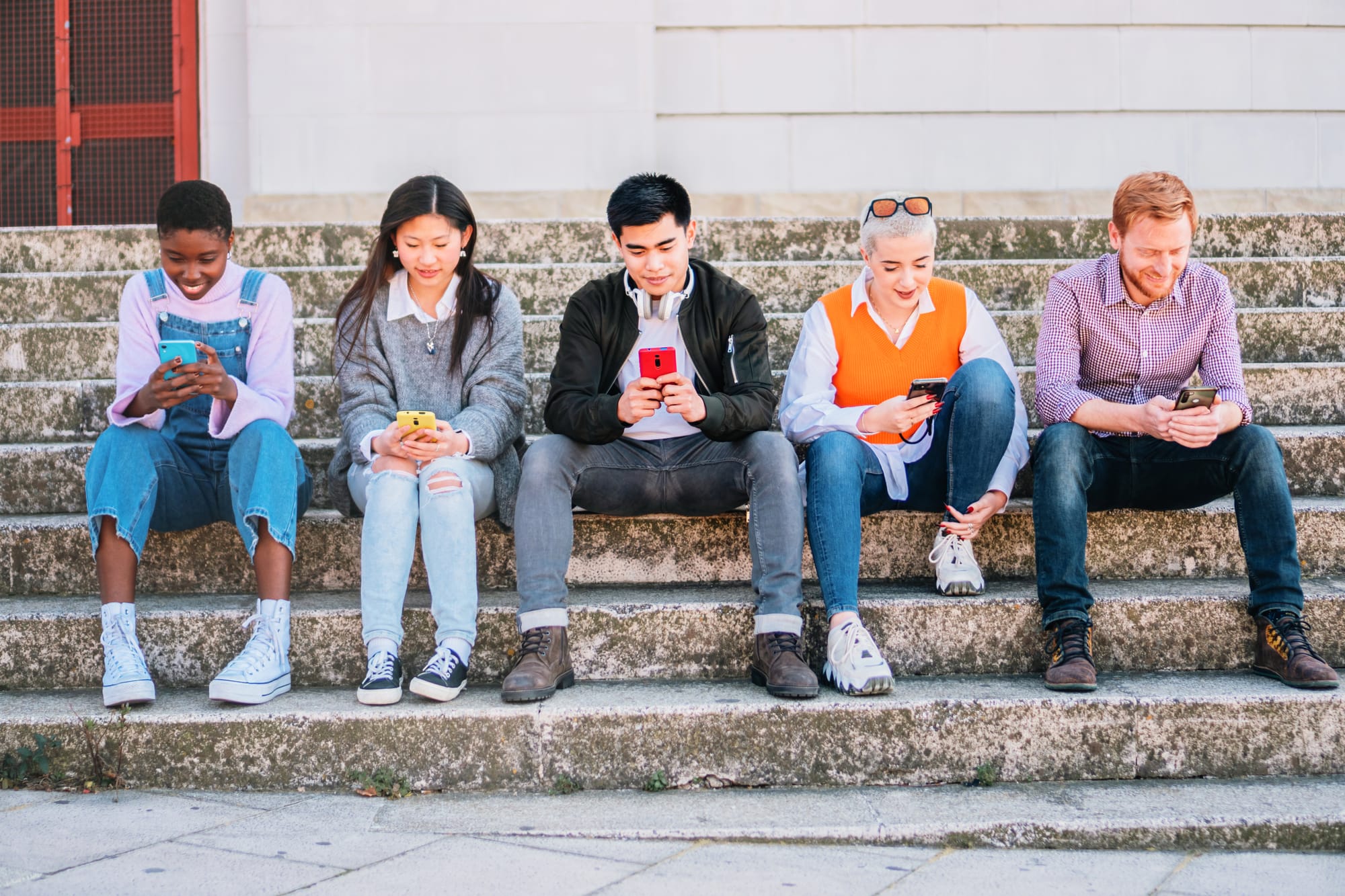Social Media Addiction: Do You Have It? (and How To Cut The Craving)
Social media addiction is a real thing. And if you're struggling to get things done because you want to touch your phone 24/7, read this article.

You’re 2 minutes into doing something important — finishing up that report due tomorrow, compiling your weekly grocery list, reviewing your credit card statements for unauthorized transactions … and you think you hear your phone buzz.
It’s right in front of you, so you pick it up. There’s nothing. No new notifications.
“Huh,” you think as you tap on the blue icon with the ‘f’/the rainbow-colored icon with an abstract camera/the black icon that makes you feel like you’re tripping.
(FYI, it’s Facebook, Instagram, and the app that may be banned in the United States as soon as January 2025.)
You blink, and 30 minutes is up.
“Shit, I better get back to work.” You put your phone down, pick up whatever you were working on, and just 2 minutes later … *imaginary buzz* It’s like Groundhog Day. Except, instead of getting a happy ending, you get nothing done 🤦♀️.
Meet, social media addiction
If that sounds familiar, we have 3 words for you: social media addiction.
Social media addiction — which has been identified as a possible behavioral addiction — is characterized by problematic social media use that negatively impacts psychological and everyday functioning.
Is social media addiction bad?
TBH, that question is fair.
Compared to being addicted to drugs like alcohol, nicotine, or cocaine, where there are clear adverse outcomes, social media addiction seems almost mild. You’re just scrolling with your thumbs; what’s the harm?
Loads, as it turns out.
The signs and symptoms of social media addiction could look like any other substance use disorder, and may include:
Plus, there are also the downsides associated with social media use itself (barring the addiction bit) in areas related to body image, eating disorders, and social comparison. Of course, social media is not all bad. It has been linked to:
- Social well-being
- Strong friendships
- Exposure to diverse perspectives
But if you related, like, hard with the introduction of this article, where you can’t go a few minutes without itching to tap on those damned apps, then your social media usage is likely already problematic.
Translation: it’s probably a good idea for you to try to wean yourself off social media or, at the very least, spend less time scrolling.
How to spend less time on social media
OK, how can you escape the chokehold social media has got you in?
Here are a few tips.
#1: Identify your triggers
Start noticing when you get the urge to touch your phone or open social media on your browser.
(Yes, we didn’t forget that you can use social media on browsers … but genuine question — does anyone do that anymore???)
When you catch yourself in that vulnerable moment, pause and ask yourself: “Do I need to do this right now? Is it an emergency? Will someone be in trouble if I don’t pick up my phone?”
This pause helps you interrupt an otherwise automatic behavior (i.e., get the urge —> touch phone —> open social media apps).
#2: “Marie Kondo” your phone
This step might be extreme for some, but you could delete social media from your phone if you think it’ll work for you. The rationale here is simple. If it’s not on your phone, you can’t use it. Genius.
And if you’re implementing this tip, don’t forget about the browsers.
For those, check out website blockers, such as Freedom, SelfControl, and BlockSite. A special mention on BlockSite, just because we spotted a hilariously relatable five-star Google review:
“I literally downloaded this just for blocking TikTok … which is a stupid toxic site/app/idea humanity has ever invented.”
Some website blockers are free, while others are paid. You should choose one that offers you the features you’re looking for and suits your budget.
#3: Set time limits on your social media usage
Don’t want to delete your social media apps because you know you’d re-download in 10 minutes?
Then, consider setting time limits on those apps. You could do it right on your phone; once you hit that set time limit, the app will automatically lock until the next day.
Here’s how you could set time limits for:
iPhones:
- Go to Settings > Screen Time
- Tap App Limits, then tap Add Limit
- Select 1 or more app categories (To set limits for individual apps, tap the category name to see all the apps in that category, then select the apps you want to limit)
- Tap Next at the top right, then set the amount of time allowed (To set an amount of time for each day, tap Customize Days, then set limits for specific days)
- When you finish setting limits, tap Add
Android phones:
- Open your device’s Settings app
- Tap Digital Wellbeing & parental controls
- Tap the chart
- Next to the app you want to limit, tap Set Timer
- Choose how much time you can spend on that app
- Tap OK
#4: Dedicate a specific hour of your day to social media
Don’t think time limits would do the trick for you either?
Then try blocking off a particular chunk of your daily schedule for social media use — you could call it “The Great Scroll”.
Possible slots include:
An unintended benefit of “The Great Scroll” may also be that you don’t need an hour to go through social media at all. There’s only so much stalking you can do on your exes *cue gasp* before you get bored.
Now, you may ask, “What will I do with the rest of my day?”
When you’re not spending your time with your face glued to your phone, you’ll find that your day becomes wide open for other enriching activities. We’re biased, obviously, so we’ll tell you about an activity you shouldn’t skip out on.
Physical activity. Namely, strength training.
So, if you need help getting started, why not check out GymStreak, the smart, AI-powered workout planner with in-built nutrition tracking that’ll get you fitter than ever?
A quick preview:
Workout Programming + Nutrition Tracking, Off Your Hands
*sigh of relief* We'll guide you through it all — step-by-step. Just download the app, and you'll be making progress toward your dream body like never before.
References
Keum, Brian TaeHyuk, et al. “Benefits and Harms of Social Media Use: A Latent Profile Analysis of Emerging Adults.” Current Psychology (New Brunswick, N.j.), July 2022, pp. 1–13. PubMed Central, https://doi.org/10.1007/s12144-022-03473-5.
Morris, Anne M., and Debra K. Katzman. “The Impact of the Media on Eating Disorders in Children and Adolescents.” Paediatrics & Child Health, vol. 8, no. 5, May 2003, pp. 287–89. Silverchair, https://doi.org/10.1093/pch/8.5.287.
Samra, Adele, et al. “Social Comparisons: A Potential Mechanism Linking Problematic Social Media Use with Depression.” Journal of Behavioral Addictions, vol. 11, no. 2, June 2022, pp. 607–14. PubMed Central, https://doi.org/10.1556/2006.2022.00023.
Tullett-Prado, Deon, et al. “Conceptualising Social Media Addiction: A Longitudinal Network Analysis of Social Media Addiction Symptoms and Their Relationships with Psychological Distress in a Community Sample of Adults.” BMC Psychiatry, vol. 23, July 2023, p. 509. PubMed Central, https://doi.org/10.1186/s12888-023-04985-5.
Zhao, Jin, et al. “Risk Factors Associated With Social Media Addiction: An Exploratory Study.” Frontiers in Psychology, vol. 13, Apr. 2022, p. 837766. PubMed Central, https://doi.org/10.3389/fpsyg.2022.837766.

